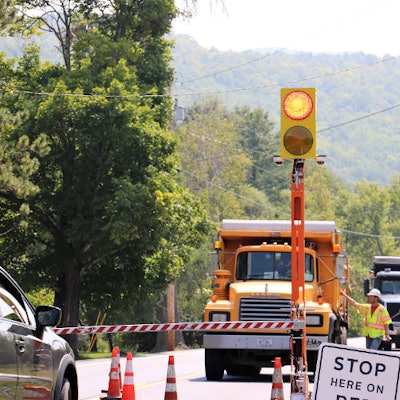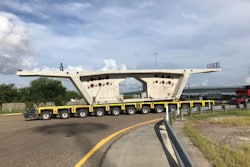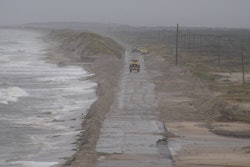 Site 2020’s Guardian SmartFlagger is a new product that NAPA chairman Craig W. Parker will be employing for his employee-owned company, Silver Star Construction of Oklahoma City. Federal statistics say a work zone crash happens about every 5.5 minutes in the United States. One of the latest victims is an Illinois man killed Sept. 14 while flagging.
Site 2020’s Guardian SmartFlagger is a new product that NAPA chairman Craig W. Parker will be employing for his employee-owned company, Silver Star Construction of Oklahoma City. Federal statistics say a work zone crash happens about every 5.5 minutes in the United States. One of the latest victims is an Illinois man killed Sept. 14 while flagging.The death of Frank Caputo while working as a flagger on the Illinois Tollway last Friday night is one more tragic reminder of the industry’s priority to better protect crews – especially flaggers – and it comes as many companies seek new ways to do that.
Caputo, of Bartlett, Illinois, was killed on the Tri-State Tollway near O’Hare International Airport by a car that careered into the work-zone. It hit Caputo and then a parked construction van, according to Illinois State Police.
A construction worker since his teens, Caputo had told his wife, Richards Caputo, of times when cars had almost hit him while he worked along roadways, she told the Chicago Tribune.
 Frank Caputo was killed while working as a flagger on Interstate 294 near Des Plaines late Sept. 15.
Frank Caputo was killed while working as a flagger on Interstate 294 near Des Plaines late Sept. 15.“His biggest fear was to die this way,” the newspaper quotes her as saying. “We are absolutely devastated.”
Every year, more than 600 people are killed in this sort of work zone accident. According to the National Asphalt Pavement Association, of the 765 people who died from work-zone crashes in 2016, about one in five were road workers.
That’s why last week in Washington, D.C., work-zone safety was one of the priorities discussed by members of the National Asphalt Pavement Association’s Impact Leadership Group, many of whom are seen as future leaders in the industry. It’s such a priority for industry groups that last spring, NAPA launched the “WatchForUs” campaign, which targets distracted drivers.
Among those in attendance at the Impact Leadership Group Conference was Craig Parker, NAPA chairman and vice president of Silver Star Construction of Moore, Oklahoma.
In April 2017, a distracted pickup-truck driver critically injured one of Silver Star Construction’s flaggers, a young man who has recovered physically but remains off work as he continues to recover from a traumatic brain injury, Parker says.
Since that tragedy, Parker has been in close contact with two Oklahoma companies, Action Safety and Direct Traffic, which have helped Silver Star stay abreast of new technology as it comes out. Last week, Parker learned of a new “smart” technology product by Site 2020.
And so on Sept. 10 – just a day before the conference – Parker decided that his company will begin using the new technology aimed at keeping flaggers safe, he tells Equipment World.
Site 2020 says its patented vision system and the modular design enables a single trained operator to manage an entire site. The Guardian SmartFlagger Automated Flagger Assistance Device (AFAD) is easy to use and simple to deploy.
A live video feature records traffic at each site entrance. Advanced software allows a paving or other road construction company to control up to 4 Guardian SmartFlaggers.
This connected site runs smoothly, safely and can be managed manually or with our pre-programmed automatic settings, the company says.
Features of this device include a unit design best suited for short-term worksite, manual mode or automatic timers (simple transition between required site settings), a conflict monitoring chip for each unit and seven days of recorded video. It’s MUTCD compliant.
Caputo’s death came at a short-term worksite–the type of situation in which the Guardian SmartFlagger works best.
“This crash occurred in a work zone where temporary lane closures were in place for overnight lane repairs, so this was not a work zone where long-term construction was occurring,” explains Daniel Rozak, a spokesman for the Illinois Tollway.
AFADS are getting smarter
The National Work Zone Safety Information Clearinghouse provides information on automated flagger assistance devices (AFADs), which are mechanically operated temporary traffic control devices that function under the same operational principles as traditional flagging.
According to that organization, AFADs are considered a safety enhancement because they minimize flaggers’ direct exposure to traffic by allowing them to control the flagging device from an area away from traffic, such as behind a guardrail. As a result, the AFAD increases worker safety compared to traditional flagging methods. It is important to recognize that AFADs do not eliminate the need for qualified flaggers in the work zone.
Going to the next level, the new product by Site 2020 says it offers the only “smart” traffic control system for jobsites.
“A connected jobsite allows companies to get more done safely than ever before,” the company says on its website, “Through our intuitive tablet-based interface and on-unit camera network, our wireless technology can be easily managed by a single person anywhere on the jobsite.”
Other such products are in testing.
In Minnesota, for example, a research team has worked with a trailer manufacturer to develop a moving automated flagger assistance device (AFAD) that signals traffic at work zones. Field testing on the well-received device continues as this construction season gets underway.
Minnesota Department of Transportation developed this Automatic Flagger Assistance Device (AFAD) for moving road work zones, such as pavement crack sealing operations.
Illinois officials urging drivers to take care in work zones
Today, Illinois Tollway and Illinois State Police officials were to hold a news conference to urge drivers to take care in work zones following the September 14 fatal incident on the Tri-State Tollway (I-294) near Rosemont. Illinois State Police were to be on hand to provide available details regarding the incident.
The tollway and Illinois State Police are urging drivers to use caution in work zones to increase safety and reduce work zone crashes along the 294-mile Tollway system to better protect construction workers, Tollway maintenance workers, first responders and the drivers using the roadways.
Meanwhile, the driver of the black 2013 Infiniti that drove into the work zone and hit Caputo about 10:17 p.m. Friday remains under investigation, according to Illinois State Police. Caputo was pronounced dead about an hour later at a local hospital. No charges were filed as of Monday against the driver.
Over the weekend, the Illinois Tollway issued a statement expressing condolences to Caputo’s loved ones.
“This incident tragically emphasizes once again the importance of drivers slowing down in work zones for the safety of our construction workers, Tollway maintenance workers, state police and first responders,” the statement says.
And on the website for Cumberland Chapels of Norridge, Illinois, which is handling Caputo’s services, one of many mourners who left written condolences implored his fellow union members to step up and lead the way.
“I’m asking all union members when coming to a construction zone, put on flashers and become a pace car and do the construction speed limits,” that man wrote.












